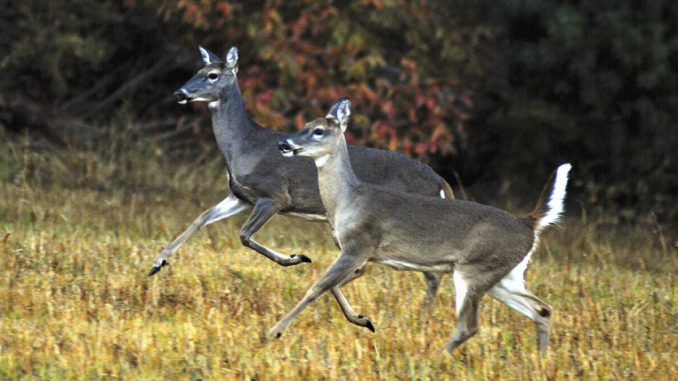
Huge mast crop, outbreak of EHD are main causes for drop, biologist says
North Carolina hasn’t experienced back-to-back deer-hunting seasons like 2013-14 and 2014-15 since records have been kept by the N.C. Wildlife Resources Commission. In 2013-14, hunters tagged a record 188,130 whitetails. But in 2014-15, the harvest dropped a record 18.3 percent to 144,315 deer, the lowest harvest since 2005-06.
A perfect storm of three major factors collided — an outbreak of epizootic hemorrhagic disease (EHD) mostly in areas north of Raleigh and in the northeastern corner of the state, a record mast crop and long-standing high doe harvests in many of the same areas — to knock the harvest back.
EHD is a cyclical illness of whitetail deer transmitted by biting insects called “midges.” The insects’ saliva contains viruses that effect only deer, with symptoms including excessive salivation, high fever, loss of appetite, rapid pulse and respiration rates, plus swollen and sore feet that make walking difficult.
Most experts believe wet weather exacerbates midge production, plus high concentrations of deer give EHD-carrying gnats more targets to infect. Herds also may lose natural immunities to the virus as time passes, making outbreaks cyclical and appear more severe.
A huge mast crop, the largest in 25 years, dropped millions of acorns in the woods last fall. As a result deer didn’t have to travel long distances to find food and were less vulnerable to hunters, especially those in stands around fields or over bait piles.
“If people hunted field edges and agricultural areas, they may not have seen a lot of deer in the open because the deer stayed in the woods and ate acorns,” said Evin Stanford, the Commission’s lead deer biologist, who described the mast crop as the second-largest since 1983.
“This included acorns to soft mast, such as grapes and other natural foods,” he said. “From the coast to the mountains, we heard hunters saw no deer. But if you hunted over bait and acorns, you probably didn’t see many deer.”
Stanford also noted that several years of strong harvests, including last year’s record kill, and increasing number of does in the harvest, potentially contributed to population decreases in some areas.
Stanford said that northern Piedmont and northeastern counties had the biggest drops in harvest last season: 35.4- and 24.5-percent, respectively.
Still, many of the same counties in the northeastern section of the state continued to lead overall state harvest totals.
Northampton County maintained its ranking as the state’s No. 1 deer county with 4,516 — a significant drop from 5,723 in 2013-14. Neighboring Halifax suffered a big drop but held onto its No. 2 rank with 3,921 deer. Bertie followed in third place last year with 3,798 registered whitetails. Anson and Union counties were fourth and fifth, respectively, with 3,583 and 3,062. Rounding out the top 10 were Wilkes with 2,956, Randolph 2,917, Rockingham 2,818, Bladen 2.787 and Beaufort 2,681.




Be the first to comment